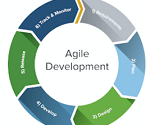SDLC RAD Model and Phases
Introduction:
The RAD model is known as Rapid Application Development model. It is a type of incremental model. In the RAD model the functions and components are developed in parallel as if they were in a small project. The developments are with the time, delivered and then assembled into the working prototype.
Phases of RAD model:
The phases in the rapid application development model are:
Business modeling:
On the basis of the information flow is identified between various business functions, the product is designed.
Data modeling:
Information gathered from business modeling is refined into a set of defined data objects that are needed for the business.
Process modeling:
Data objects defined in the data modeling phase are converted to achieve business information flow necessary to implement a business function. Descriptions are identified and are created for the CRUD of data objects.
Application generation:
Automated tools are used to convert process and data models into prototypes and the actual system.
Testing and turnover:
Test new components and all the interfaces and they are individually tested during every iteration
Advantages of the RAD model:
- Reduces the development time.
- Every phase in RAD delivers highest functionality to the client
- Increases re-usability of the project components
- Initial reviews will occur quickly
- It encourages the customers feedback
- Due to the nature of prototyping , there is a possibility of lesser errors.
Disadvantages of RAD model:
- Depends on the strong team and performances for identifying business requirements.
- It is not suitable for smaller projects
- The RAD model is not compatible for all applications.
- It is not suitable, When technical risk is high
- It requires highly skilled designers and developers
- Modeling skills has high dependency
- Inapplicable to cheaper projects as the cost of modeling
- Automated code generation is very high.
When to use RAD model:
- RAD should be used when the user will be involved all through the life cycle
- It is used When there is a necessity to create a system that can be modularized in 2-3 months of time.
- RAD models should be chosen only if the resources with the high business are available and there is a necessity to produce the system in a short span of time .
- It is used when technical risk is less in the project.
Conclusion:
RAD is a concept that can be difficult to adhere to for some companies. If your company relies on multiple teams coordinating with each other for a single project, then it’s difficult to incorporate RAD software into those situations. But if you’ve got the agility to quickly cycle between prototyping and feedback–if you’ve got talented developers who are ready to change anything at a moment’s notice–then it’s worth giving rapid application development a shot.



